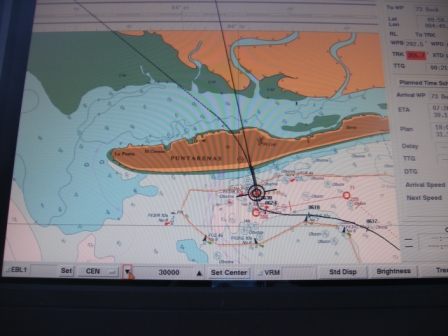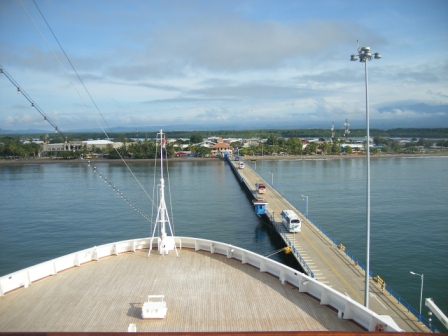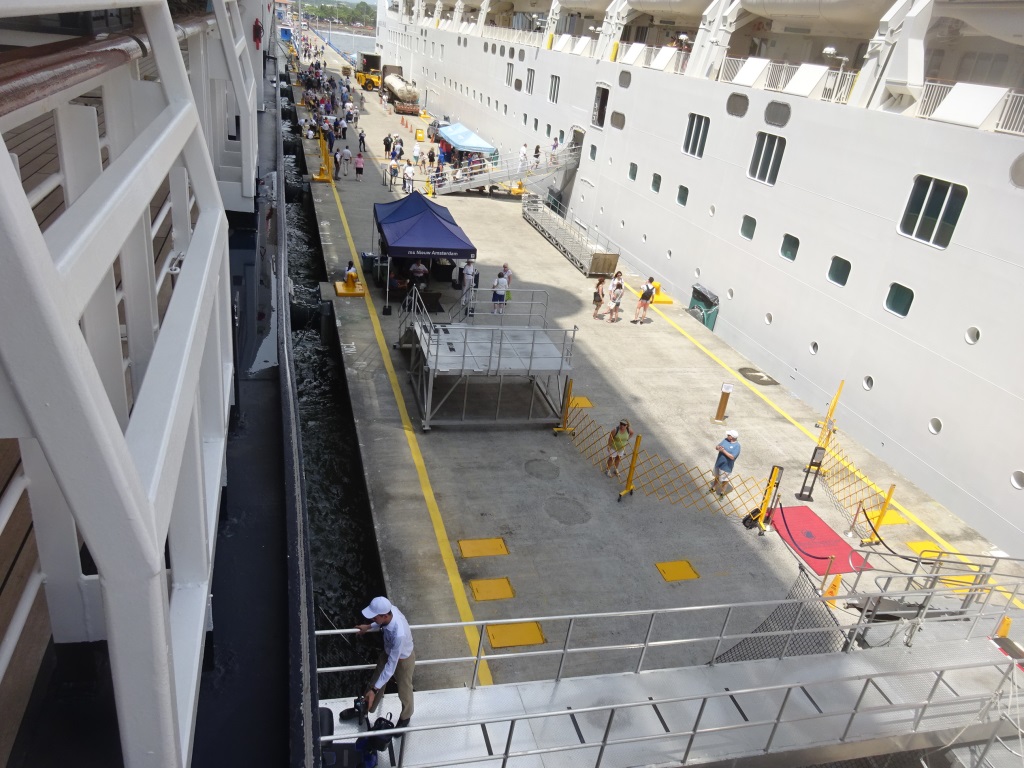When I was blogging from the Zuiderdam 14 days ago, we called at Puerto Limon Costa Rica; and now we call at the opposite side of the country at Punta Arenas, Costa Rica. Different port but for the rest it is nearly all the same. Costa Rica is not a large country, only 5 million or so inhabitants but it is a well-organized and a very stable country. What the Costa Ricans have realized at a very early stage is that Mother Nature gave them a very rich country and in return they are looking after it very well. Electricity comes from Hydro Power and Solar Panel farms and the carbon footprint has been greatly reduced by planting a large number of trees.
Eco Tourism to the jungles of Costa Rica has always been an important part of the Costa Rican income and in the recent years that has only greatly increased. Increasing the jungle is not that difficult, just plant the right trees and the jungle takes over in no time. Mostly they have been replanting areas which in the past were subject to deforestation, which is never a good thing, but in areas where there is a lot of rain it can be devastating. The fertile topsoil is washed away, never to return. The only area they are still struggling with it is the traffic. As the economy is doing quite well, more and more cars are appearing on the roads and the roads are not getting much bigger as there is no space. From the coast to the capital San Jose up in the mountains roads have to be carved through the mountain ranges and at San Jose there is not much space either. The capital is located on a plateau quite high up and a bit in a dip, so you cannot easily construct a ring road around it all. The dip ensures that smog and exhaust gasses do not dissipate very quickly and that is something that is easily recognizable when you arrive or depart by airplane. They have plans to electrify large parts of the commuter traffic here and that should not be as difficult as they have sufficient electric power capacity available.

Punta Arenas is located at the west end of a Peninsula so swell and current have no natural obstructions anywhere.
One thing that is different here is that they have split the cruise port away from the cargo port. In the good old days of the Rotterdam V, who trail blazed HAL cruising here, we always docked in the cargo port of Puerto Caldera. But then you took a spot away from the cargo ships. So in the late 1990’s some deep thinkers decided to build a cruise terminal and the most favorable location for the shore side was at Punta Arenas about three miles to the west. They did not really consult the professional mariners; otherwise the pier would not have been built there. In this location we suffer from strong currents and high swells which make a captain go grey before his time; but the pier is in line with the Main Street of Punta Arenas and thus that is what the shopkeepers decided was best. Had they built a breakwater in front of the pier (as they have in Puerto Caldera) then it would have not have been so bad but that would have cost extra money. So we suffer from a lot of broken mooring lines due to a bouncing ship.

Because the area is quite shallow a long bridge/pier had to be constructed and that is why they bring the tour buses all the way to the ship. This picture show s the bow of the ms Veendam.
But enough of my moaning and groaning. We were lucky today as we have been in the last few ports. There is still no swell and the wind blew over the land so it could not whip up any waves. The ms Volendam lay steady alongside the pier all day. Docking was still a bit of a challenge due to the current running but it was not as bad as we had prepared ourselves for it before we arrived. We were also by ourselves today which made life easier as well. Two ships alongside, which means a double number of shore excursion buses coming to the pier and one or two trucks with vegetables parking right in the way, can cause chaotic scenes. We like to buy vegetables and fruit here as it comes fresh from the farm. Very often directly from the land. The Hotel Director orders the day before and whatever we order is harvested at sunrise and is at the ship 3 hours later. One of our Hotel Directors once told me that one of the Exe. Chefs managed to have fresh mango served in the Lido at 11.30 hrs. while those mango’s had been hanging on the tree (mango tree or mango plant ???), five hours earlier.

Two large ships alongside and lub oil tankers and gangways and supply trucks. With two ships it can be quite hectic on the pier. This is a photo of the ms Westerdam alongside with a NCL ship.
What do we do here? Costa Rica is the Valhalla for Eco tours. (Apart from going to San Jose of course) For the active ones there is zip lining and for the more sedate a canopy gondola, River cruises, Nature and Cooking, Botanical Gardens and swamps, birds and sloths, butterflies and Andalusian horses; and for the very cultural minded there is the Starbucks Coffee Farm excursion. I have done here in the past the San Jose tour, which is quite heavy on museums and where, to my utter amazement, I came across ship models from a Dutch company called the KNSM or Royal Boat which used to sail here in the days before containers. I wonder if they are still there as they were fully exposed to the tropical temperatures and humidity.
Because of the strong current under the dock we cannot just depart when we want. We have to wait until a tugboat that is watching the current swirling around a buoy nearby gives the green light. That means we have to get everybody back on board on time but then we still might have to wait an hour before the current changes. And that is here quite erratic compared to the rest of Middle America.
Tomorrow we will have a restful day at sea and then we sail through the Panama Canal. For the weather: the cloudiness is supposed to increase which is not unusual as on the border between Panama and Costa Rica it rains a lot with sometimes the most spectacular lightning storms. So we might get a few drops over the ms Volendam as well.

March 13, 2019 at 10:49 am
Thank you Captain for sharing your insight on life aboard the seas. It is an enjoyable and informative look at the daily challenges a Captain faces with each different port. As 40 year sailors of Lake Michigan and the Caribbean, the challenges we faced were minor to what a cruise ship faces but non-the-less the anxiety index was high for both of us. We’re about to embark April 7th on a 22 day TA crossing and Med cruise on HAL MS Koningsdam. Your comments encourage a new level of appreciation for what it takes.